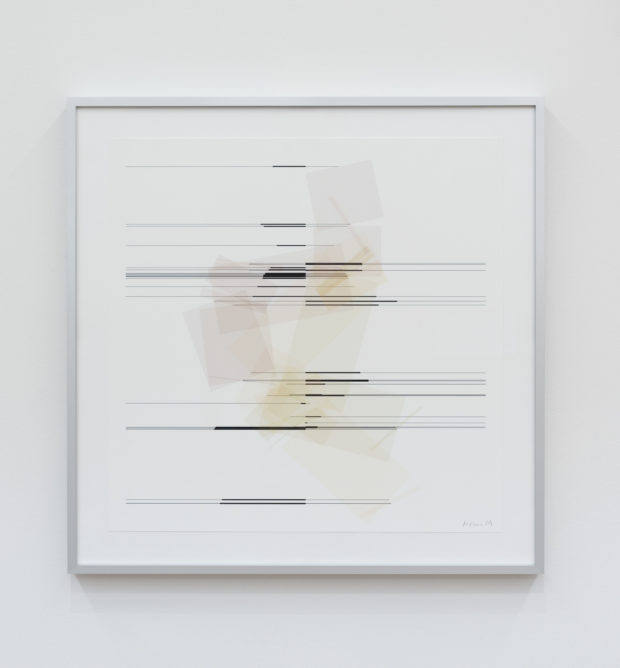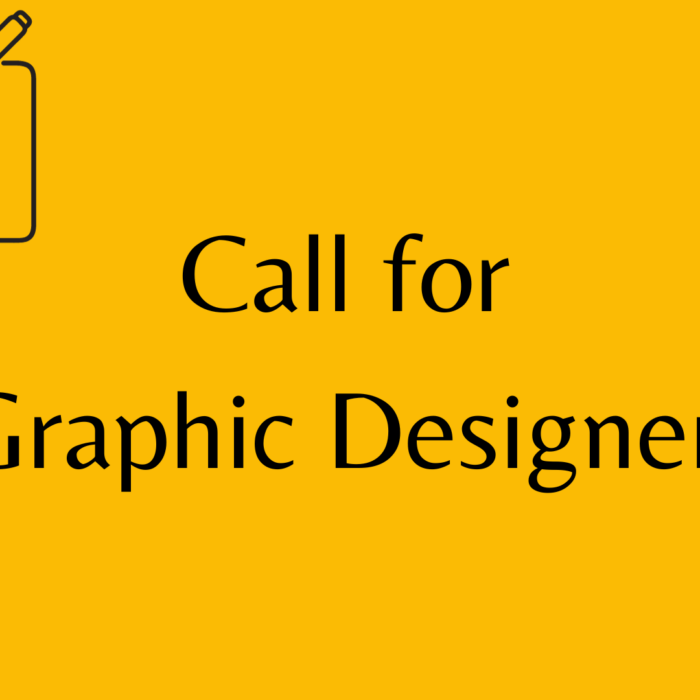You have no items in your cart. Want to get some nice things?
Go shopping
Manfred Mohr
……. …….
P2602-cc_14, 2019
Pigment ink on paper
20.25 x 20.25 in
Algorithms don’t seem like fun. New sources regularly announce how algorithms are responsible for assorted prejudices against certain populations that will only get worse. They are part of the reason that artificial intelligence is getting stronger every day, going to take over jobs, and make humanity useless. But even if these dire forecasts are true, there is another side to algorithms epitomized in the art works of Manfred Mohr.
Mohr had been an abstract painter and a musician before he turned to computers. He played the tenor saxophone and oboe in jazz clubs across Europe and was a member of the band Rocky Volcano. Reading about Max Bense’s information aesthetics in the mid 1960s, however, launched Mohr on a career-defining trajectory. Bense aimed to create a rational aesthetics and “program the beautiful.” His work influenced many across Europe to investigate the computer as a system of art making. He saw the computer not as a mere tool but as embodying the rule of art. Many engineers started creating art-producing programs, contributing to the later explosion in graphic design. For Mohr, Bense provided a new way of thinking about art. If algorithms allowed a sense of order, then introducing randomness was a means of introducing the unforeseen, akin to the artist’s intuition. Mohr would later say: “Even though my work process is rational and systematic, its results can be unpredictable. Like a journey, only the starting point and a hypothetical destination are known. What happens during the journey is often unexpected and surprising.” His works are visual analogues of the algorithm’s process. They are the visualization of an event.
An algorithm is, at its simplest, a set of instructions. It provides a set of rules for a specific procedure. Roman Verostko, an artist who left the priesthood to become one of the pioneers of computer art, explains that even a recipe for baking a cake can be understood as an algorithm. The cake is the visualization of the process that is an algorithm. The formula on the page appears static, but it describes an event in time and space. Euclid’s geometry provides algorithms that, for example, lead to Proposition I.48 wherein the square of two sides of a right angle triangle equal the square of the hypotenuse. Beyond mathematics, however, algorithms appear in many common situations, like knitting or tying shoes. What transformed the concept of algorithms was the advent of the computer. Computers made it possible to solve far more complicated problems within a useful time frame. For some, the extraordinary power of those calculations also meant a new ability to generate forms.
Software wasn’t commercially available until the 1980s so most of the original artists using computers needed the ability to program. They designed algorithms but also recognized that the process could be made visual with devices like plotter arms (a kind of robotic arm for drawing). Jean Pierre Hebert proposed the term algorists in 1995 for those who create an object of art with a process that includes their own algorithms. Included in the original list were Yoshiyuke Abbe, Harold Cohen, Charles Csuri, Herbert Frank, Hiroshi Kawano, Manfred Mohr, Frieder Nake, Georg Nees, Vera Molnar, and Edward Zajec, all part of this early period of computer art. Hebert even created an algorithm that determined an algorist, which speaks to the playfulness of the group and their idea of what it means to work with algorithms:
if (creation && object of art && algorithm && one’s own algorithm) {
include * an algorist *
} elseif (!creation || !object of art || !algorithm || !one’s own algorithm) {
exclude * not an algorist *
}
Mohr’s titles all include the numbers that are significant to the algorithm. The first number references the specific body of work. For example, in the case of P2400-299_714, 2400 is the number Mohr assigns to the series. 299 refers to an older program he wrote in 1978 which is an important and substantial aspect of the P2400 series. The number 714 is the random number from which that particular drawing process started. It would be a mistake however to think his work is about the math. He uses multidimensional hyper cubes and charts paths through them to expand what people can see and think. In the early days, he was one of the few artists who found respect across the sciences and humanities. Scientists appreciated his work because of his precision and rationality while the art world recognized the purity of his abstraction as a clearly aesthetic practice.
Similar but different
When Sol Lewitt wrote that “the artist would select the basic form and rules that would govern the solution to the problem,” he could have been describing the type of work that Mohr was doing. Similarities exist between conceptual art and algorithmic art in the 1960s. Both aimed to eliminate the artist’s presence. Lewitt wanted to disassociate from the individual craft of the artist; the process should be able to be replicated by anyone. The works of Mohr, likewise, eliminated any spontaneous gesture. The algorithm was fixed and the plotter arm drew the work as indicated.
The stunning resemblances between Mohr’s P-154-C (1973) and Lewitt’s Variations of Incomplete Open Cubes (1974) often lead people to think the two artists, as well as conceptual and computer art, are the same. Both works display the construction and deconstruction of a rotating cube, adding and removing one line at a time. In a grid-like formation, Mohr’s investigation of the cube occurs across ten images for seven lines, while Lewitt’s grid is thirteen by ten. Despite the impersonal use of serialization, standardization, and a strict logic and order suggestive of a certain commonality, Grant D. Taylor describes the radically different critical reception of these works in When the Machine Made Art (2014). He explains how those engaged with computer art did not write manifestos or articles articulating their relationship to other avant-garde movements. They did not present philosophical statements. Computers were seen as “cold and soulless” and so the works were too. Today, the term digital art is most common but despite the change of term, many audiences still reject its artistic merit.
A difference can also be drawn to those who combined art and technology but weren’t specifically interested in how technology produced visual forms. In 1966, Robert Rauschenberg collaborated with the Swedish physicist Billy Klüver to produce a series of performances at the New York City 69th Regiment Armory. It laid the groundwork for Experiments in Art and Technology (EAT) the following year, a movement largely responsible for introducing technology within art practice in the United States. EAT brought artists and engineers together, as well as industry professionals from companies like AT&T, IBM, and Pepsi, to encourage collaborations across the disciplines. At that time, computers were large, cumbersome objects mostly held in research facilities, so artists who wanted to produce works had to find willing partners in the military and science fields. This had led to culture clashes, as described infamously in C.P. Snow’s 1959 Rede lecture, then published as The Two Cultures and the Scientific Revolution.
In the post-war period, use of computers was largely dedicated to the growing technocratic military-industrial complex. Mohr was once accused of using a “devilish capitalistic instrument” and someone else at that same lecture threw an egg at him, all because he used computers. EAT participants aimed to reorient the cultural potential of the computer to transform the social order. Rather than cultivating ever better tools of war or expanding industrial pollution, the arts could harness technology to “infiltrate engineering and reform industry,” as the digital artist and critic Edward Shanken would later describe of the movement.
In this way, EAT had a significant socio-political goal to question the underlying moral implications of technology, an attitude that was not present in many computer artists whose background in mathematics and engineering often did not feel a need to examine the social implications of what was for them simply their tool. Since EAT sought these larger goals, it wasn’t particularly focused on the computer and so embraced all media. They produced large-scale performances, sound works, and displayed the computer as a part of the visual art work. This distinguished it from computer artists specifically interested in the potential aesthetic output of the computer.
Algorithms for a new generation
Mohr continues to produce works but many artists these days are more interested and concerned by the impact of algorithms within social structures. Algorithms allow for quantities of data to be analyzed and turned into specific results. Target could identify pregnant women by their shopping, long before those pregnancies were apparent or shared with family. The algorithms of many social media sites have been blamed for creating filter bubbles, whereby audiences only see posts, news, and advertisements that are similar to what they have liked previously.
Many companies use algorithmic decision systems to mitigate human error, improve accuracy, cut costs, and increase efficiency. Unfortunately, as evidence of bias and harm increases for those within criminal justice, education, employment, and healthcare systems, there is inconsistent proof of their benefit. Organizations like Data & Society or AI Now actively address these issues and disseminate research to help create a more informed population. Artists like Stephanie Dinkins, Yang Jian, Esther Hovers, Jennifer Lyn Morone, Inc., Trevor Paglen are only some of the many artists addressing these complex issues in very different forms and formats. Daniel Canogar is among those whose work responds to environmental factors. Jim Campbell examines notions of memory in a world of databanks. The list goes on.
A tendency remains to clump artists working with technologies together, as if all were somehow doing the same thing. Just as we recognize that oil painters differ widely in style and content, so do artists whose work now revolves around computers and the use of algorithms. Artists working with algorithms may actually produce their own algorithms to create a visual output, just as Mohr and many of the algorists did. But artists may adopt software to create projects and thus implicitly use algorithms; just about any artist using a computer or digital camera falls into this category. Artists may use data from others’ algorithms to create work. They may produce work about the social use of algorithms, though the art work does not per se involve algorithms or even computers. These are wildly different projects, all of which use or respond to data and algorithms.
For Mohr’s most recent show at bitforms gallery in New York City, the artist did an interview about his work. That video is titled “I Can Trust the Machine.” These are powerful words in this day when so many feel overwhelmed and confused by what the computer seems to already know about and do for us. Beyond these anxieties, however, Mohr’s work is also a reminder that algorithms in and of themselves are not the problem. The recent show’s title points a different direction for thinking about algorithms: Manfred Mohr: A Formal Language. Working with algorithms is an opportunity to create forms with affective and intellectual possibilities. Artists like Leo Villareal use algorithms to create light effects in public spaces; they may be engineering feats but audiences respond with feeling. Mohr investigates mathematical configurations to examine how we can think about what we can’t see. These inquiries remind us that algorithms can produce positive contributions. In better understanding algorithms, we can become better judges of those that harm and take pleasure in those that expand our world.
Charlotte Kent
DR. KENT is Assistant Professor of Visual Culture in the Department of Art and Design where she is also the Program Coordinator for Art History. She has published in academic and general audience venues about diverse topics related to visual culture. Her current research explores the role of the absurd in contemporary art and digital culture. She serves on the Board of Directors for the National Arts Club in New York City, where she founded the Artist Fellowship and organizes regular panel events. She speaks regularly for Artists Equity.




